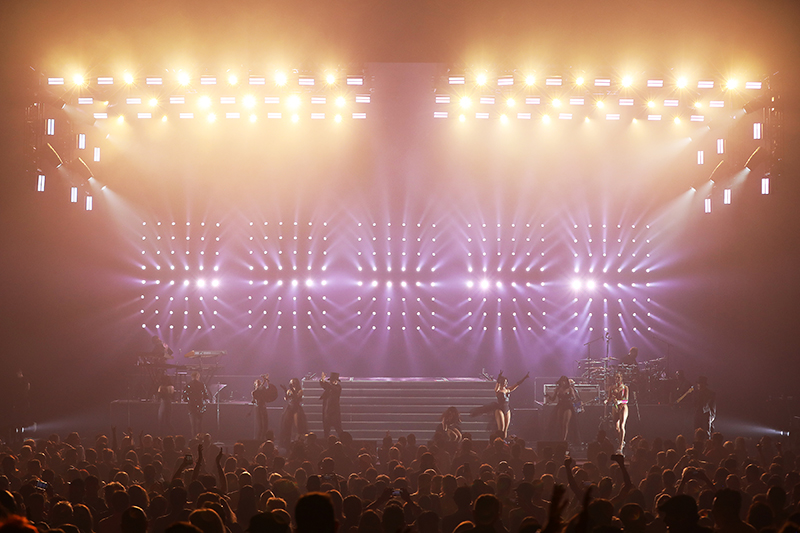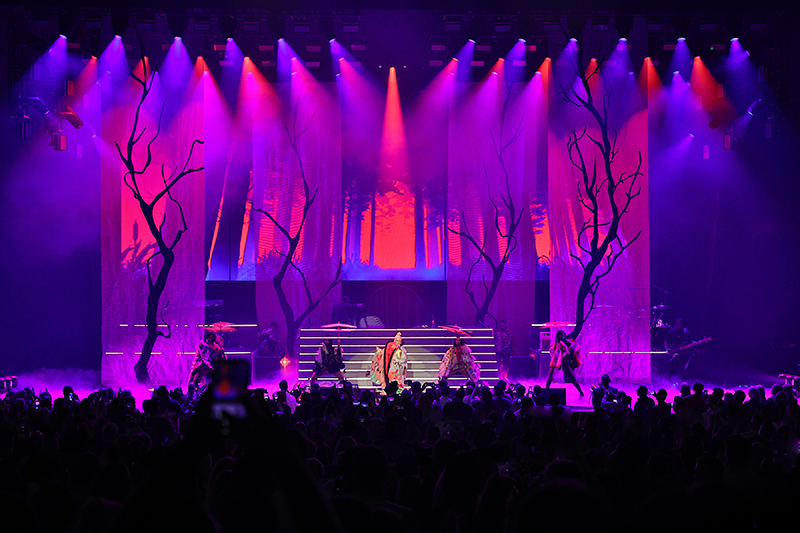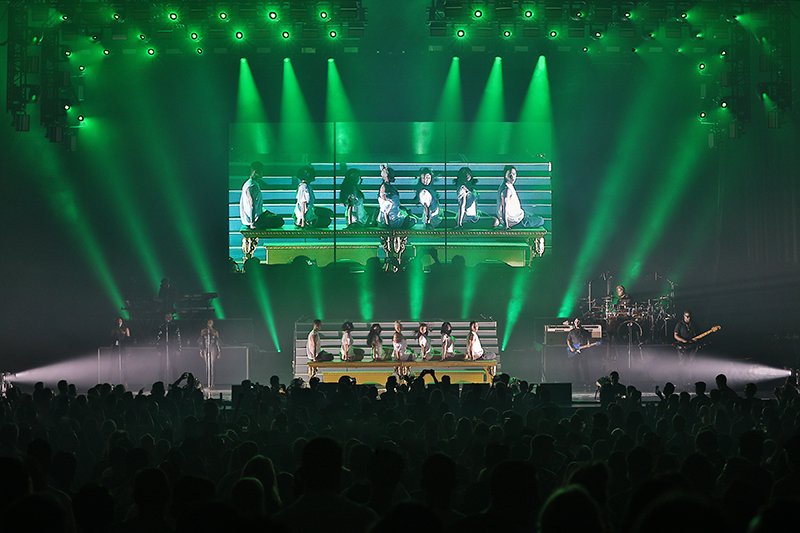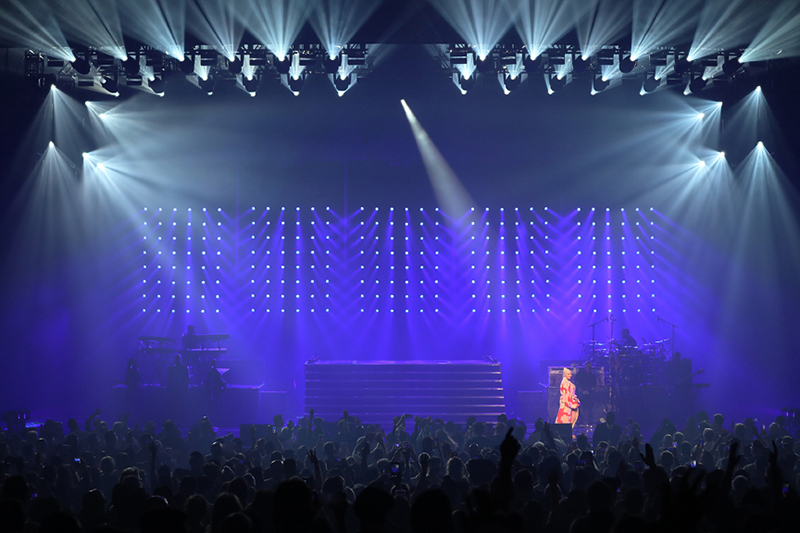
A Musical Story in Light Paints a Path to Artistic Freedom
Christina Aguilera returned to touring in 2018 after a decade of absence from the live stage, with a story to tell. Above and beyond what the media has tried to capture since her debut as “the little girl with the big voice” at age eight, Aguilera wanted fans to know the real journey to her “liberation.”
Her creative director, Jeri Slaughter, along with choreographer Paul Morente, would be channeling Christina’s concepts and visions to share her story. Christina’s management knew just the man to interpret their collective efforts and called upon designer Travis Shirley.

Not Just a Pop Tour
“This was a project I was extremely excited to be part of,” begins Shirley. “I knew within the first meeting this was not going to be your traditional pop show.”
Slaughter and Morente conveyed to him that Aguilera’s stage presence would require different levels of elevation, with cohesive but unobtrusive projection elements and a lighting design that could reflect the evolving story of her liberation. Shirley navigated the concepts of those visions through discussions and progressive phases of napkin sketches to 3D renderings.
It does not occur often that design of set, lights and video fall under one person’s purview. When they do, that umbrella gets labeled Show Production Designer, “which is the way I like to produce shows,” says Shirley.
For an overall canvas, Shirley was driven to recreate the atmosphere of a high art gallery. It was from this point that he developed the layers of elements to carry that illusion to the audience.

Frames within Frames
“I was looking for something very simple,” says Shirley, “something understated, but very effective.” Truss structure was key to this, so he designed a grid that framed the performance environment within the venue’s proscenium environment.
From the audience perspective, the lighting rig appeared as a frame-within-a-frame. Every song was a vignette unto itself, choreographed by Slaughter and Morente to accent the incredible variety of costumes Aguilera wore throughout the performance.
Through the use of video elements, projection and scenic elements that featured both kabuki and roll drop effects, Shirley built a production providing him with a large and versatile tool box from which to draw.
Mounting this elegant production to make sure it could tour efficiently fell to production and tour manager Bryan “Froggy” Cross. “Froggy’s expertise and experience was invaluable throughout the process of shaping this into a reality and ensuring the production’s integrity on a daily basis. He made this happen for all of us and Christina’s audience,” says Shirley.

Symmetric Looks
All lighting fixtures were symmetrical in position and type, both overhead and on the side pods. The workhorses in the design were Robe BMFL WashBeams and GLP JDC1 Strobes. “The commonalities gave me parallel lines allowing for a lot of matrix style looks to program,” says Shirley. Again, he was looking for a simple platform onto which he could create “lots of cool delays of intricate parameter timing chases.”
Lighting programmer and show operator Cat West had been working with Christina for several years, handling her one-off shows. She programmed the show for Shirley and took it on the road. Already well-known in the industry and to Shirley for her programming skills, “her knowledge of what works or doesn’t in lighting Christina from the sides or and a number of other details proved a great asset too,” he says. “Not that Cat needed to prove anything.”
As Shirley mentioned earlier, programming involved an intense amount of elaborate timing built in all the looks. “And I’m not talking merely cue-wise, but extremely complex macros with timing attributes cascading delays from multiple fixtures in a single move — art that only the best programmers can accomplish.” This was the underlying intention of the way he designed the lighting rig — a simple looking structure that belies the vivid way it was used.
A single Robe RoboSpot sat on the upstage truss with an operator controlling it from a base station on the floor backstage. West programmed all other parameters through the grandMA2. This was the systems debut in the U.S. Shirley had used the RoboSpot on several tours in Europe previously to spec’ing it for the Liberation tour.

Eastward Gaze
Several of the descriptions Slaughter and Morente gave Shirley as to how songs would play out had a Far East feel to them, especially in referencing Christina’s more ethereal wardrobe selections. Again, the scenic elements worked on two indistinguishable levels as the bare trees silkscreened onto the sheer material and the double kabuki mechanism echoed the perception of Asian environs. Sew What provided all the soft goods. Efficient use of the scenic elements had the roll drops working on two levels. They provided dramatic aesthetic looks and were a mechanism to provide a seamless production flow for staging changes.
Five upstage pods suspended on rotators provided by SGPS
enhanced the automated scenery and lighting integration. The pods also helped create one large LED screen out of separate elements provided by Screenworks for video playback. Each screen can move independently with varying speed or direction, creating a dramatic effect when five pods rotate a full 180 degrees to reveal a wall made from 240 Elation ACL 360i fixtures.
The creative and choreography team selected the video content appearing on the LED screens. It begins with a video of Aguilera chasing herself as a young child, and from there, the content reflects the songs on the set list until Aguilera “arrives” on the Liberation tour.

Kudos to the Crew
Shirley gives lighting vendor Morris Light and Sound and its crew on the Liberation tour high marks. “Expectations were high all right, that is a fact,” says David Haskell, president of the company Dale Morris owns. “When Travis asked us to submit a bid, we participated in the process and ended up happily getting selected to do the tour. We’ve known Travis and worked with him for about three years now.”
“Morris is what I consider a ‘boutique-plus’ company,” Haskell continues.” Small enough to care, but big enough to have what we need to get the job done. There’s that old line that anybody with a line of credit can get gear, but not everyone can maintain the level of service that we at Morris do. Our biggest assets are customer service and packaging. We do that better than anybody.”
“Morris proves themselves on every outing to be a really wonderful company with amazing gear and great crews,” Shirley says. “I needed a company that was 100 percent behind me for a lot of reasons, as they have proven in the past again and again. For starters, it’s Christina, so a lot of attention is immediately drawn to the tour. Add to that, she has not been out in over a decade, and expectations start ratcheting up further. There was not a lot of room for failure on this, and I knew that Morris could deal with the challenge in order to get this done. Like any tour starting up, there were a lot of changes at rehearsals on site. I’m happy to say the Morris Lighting crew just killed it,” he adds, with a tip of the hat to Josh Dirks, Adrean McDonald and Michael Pagan.
Collaboration with the designer is part and parcel of creating a good working relationship and maintaining that trust. “We have a vast inventory to work from but, as with anything, when art meets commerce, three factors always come into play; money, timing and the right desired fixture,” says Morris’ David Haskell. “Travis is very good at working our inventory which we keep up to date and maintained. At Morris, we take the time to consult, strategize and thoroughly invest ourselves to meet each client’s goals. Sometimes we as a vender can suggest a product that they are unaware of which ends up serving their purpose better.”
Their 55,000 square foot facility located near downtown Nashville includes an in-house previz suite. Not only do the artist and the production team get a realistic view of what the design can do, it saves everyone a great deal of money. “Collaborating in house is immensely cost-saving for production and the tour, without cranking up the trucks, hiring 50 hands and a venue,” says Haskell.
“This was very different for Christina,” Haskell adds. “It truly was ‘liberation’ for her, and very well done by Travis. The music and the pace of the show went from in-your-face rock ‘n’ roll to elegant Broadway. There was a lot of depth to what was a very simplistic but powerful system.”
“This tour was about something much bigger than just putting on a concert,” says Shirley, noting the rewards of being “a part of something that had a genuine message. And the gravity of her message was truly humbling. Being part of that, and helping her to deliver that message, was a real joy for me personally. From this whole experience I’ve learned a lot. It pushed and challenged me creatively.”

Christina Aguilera 2018 Liberation Tour
Crew
Lighting Designer: Travis Shirley
Lighting Director/Media Programmer: Cat West
Lighting Co: Morris Light and Sound
Lighting Crew Chief: Josh Dirks
Lighting Techs: Adrean McDonald, Michael Pagan
Video Co: Screenworks
Video Director/Crew Chief: Adam Walden
Video Techs: Jason Fisher, Maria Davidian
Tour/Production Manager: Bryan “Froggy” Cross
Production Assistant: Iowa Wong
Road Manager: Michele Mecca
Stage Manager: Marc Engel
Special Effects: SFX
Cryo Tech: Shane Davis
Staging Co: SGPS
Head Rigger: Daniel Wright
Carps: Kevin Murray, Daniel Fiore
Gear
2 grandMA2 Full consoles
1 grandMA2 Light
48 Robe BMFL WashBeams
1 Robe RoboSpot
54 GLP JDC1 Strobes
18 Claypaky Mythos
240 Elation ACL 360i
4 MDG Hazers



